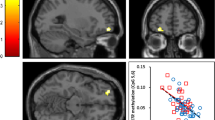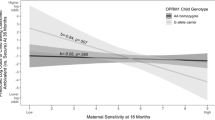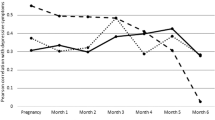Abstract
In non-clinical low-risk populations 15% of infants show disorganized attachment behavior1,2 with their caregivers in the Strange Situation,3 a mildly stressful laboratory procedure testing infants’ ability to cope with separation anxiety. Disorganization of early attachment has been primarily ascribed to inadequate parenting,2,4,5 and has been associated with childhood behavior problems6,7and adolescent psychopathological tendencies.5 We have recently reported an association between the DRD4 exon III 48 basepair repeat polymorphism and disorganization of infants’ attachment behavior towards their mother in a low-social-risk group of 1-year-old infants:8 the risk for disorganized attachment among infants carrying the 7-repeat allele was fourfold. Here we report further evidence for the involvement of the dopamine D4 receptor gene in attachment disorganization. The same group of infants was genotyped for the functional −521 C/T single nucleotide polymorphism (SNP) in the upstream regulatory region of the DRD4 gene9 in order to test the association with attachment disorganization both alone and in interaction with the DRD4 exon III 7-repeat allele. While the −521 C/T genotype itself had no effect on attachment status (χ2 = 0.41, df = 2, P = 0.82), there was an interaction between the structural 48-bp repeat polymorphism and the −521 C/T promoter polymorphism: the association between disorganized attachment and the 7-repeat allele was enhanced in the presence of the −521 T allele (χ2 = 6.61 and 6.67, df = 1, P < 0.025 for CT and TT genotypes, respectively). In the presence of both risk alleles the odds ratio for disorganized attachment increased tenfold. This result supports our previous postulation that the DRD4 gene plays a role in the development of attachment behavior in low-risk, non-clinical populations.
This is a preview of subscription content, access via your institution
Access options
Subscribe to this journal
Receive 12 print issues and online access
$259.00 per year
only $21.58 per issue
Buy this article
- Purchase on Springer Link
- Instant access to full article PDF
Prices may be subject to local taxes which are calculated during checkout

Similar content being viewed by others
References
Main M, Solomon J . Procedures for identifying infants as disorganized/disoriented during the Ainsworth Strange Situation. In: Greenberg MT, Cicchetti D, Cummings EM (eds) Attachment in the Preschool Years University of Chicago Press: Chicago 1990 pp 121–160
Van IJzendoorn MH, Schuengel C, Bakermans-Kranenburg MJ . Disorganized attachment in early childhood: meta-analysis of precursors, concomitants, and sequelae Dev Psychopathol 1999 11: 225–249
Ainsworth MD, Blehar MC, Waters E, Wall S . Patterns of Attachment: A Psychological Study of the Strange Situation Erlbaum: Hillsdale, NJ 1978
Lyons-Ruth K, Bronfman E, Parsons E . Maternal frightened, frightening, or atypical behavior and disorganized infant attachment patterns. In: Vondra JI, Barnett D (eds). Atypical Attachment in Infancy and Early Childhood among Children at Developmental Risk Monogr Soc Res Child Dev 1999 64: 67–96
Carlson EA . A prospective longitudinal study of attachment disorganization/disorientation Child Dev 1998 69: 1107–1128
Lyons-Ruth K . Attachment relationships among children with aggressive behavior problems: the role of disorganized early attachment patterns J Clin Consult Psychol 1996 64: 64–73
Vondra JI, Shaw DS, Swearingen L, Cohen M, Owens EB . Attachment stability and emotional and behavioral regulation from infancy to preschool age Dev Psychopathol 2001 13: 13–33
Lakatos K, Toth I, Nemoda Z, Ney K, Sasvari-Szekely M, Gervai J . Dopamine D4 receptor (DRD4) polymorphism is associated with attachment disorganization in infants Mol Psychiatry 2000 5: 633–637
Kamakura S, Iwaki A, Matsumoto M, Fukumaki Y . Cloning and characterization of the 5′-flanking region of the human dopamine D4 receptor gene Biochem Biophys Res Commun 1997 235: 321–326
Ebstein R, Benjamin J, Belmaker RH . Personality and polymorphisms of genes involved in aminergic neurotransmission Eur J Pharmacol 2000 410: 205–214
Wong AHC, Buckle CE, Van Tol HHM . Polymorphisms in dopamine receptors: what do they tell us? Eur J Pharmacol 2000 410: 183–203
Oak JN, Oldenhof J, Van Tol HHM . The dopamine D4 receptor: one decade of research Eur J Pharmacol 2000 405: 303–327
Van Tol HHM . Structural and functional characteristics of the dopamine D4 receptor Adv Pharmacol 1998 42: 486–490
Chang FM, Kidd JR, Livak KJ, Pakstis AJ, Kidd KK . The worldwide distribution of allele frequencies at the human dopamine D4 receptor locus Hum Genet 1996 98: 91–101
Ashgari V, Sanyal S, Buchwalt S, Paterson A, Jovanovic V, Van Tol HHM . Modulation of intracellular cyclic AMP levels by different human dopamine D4 receptor variants J Neurochem 1995 65: 1157–1165
Auerbach J, Geller V, Lezer S, Shinwell E, Belmaker RH, Levine J et al. Dopamine D4 receptor (D4DR) and serotonin transporter promoter (5-HTTLPR) polymorphisms in the determination of temperament in 2-month-old infants Mol Psychiatry 1999 4: 369–373
Lakatos K, Nemoda Z, Birkas E, Ronai Z, Kovacs E, Ney K et al. Association of D4 dopamine receptor gene and serotonin transporter promoter polymorphisms with infants’ response to novelty Mol Psychiatry 2001 (accepted)
De Luca A, Rizzardi M, Torrente I, Alessandroni R, Salvioli GP, Filograsso N et al. Dopamine D4 receptor (DRD4) polymorphism and adaptability trait during infancy: a longitudinal study in 1- to 5-month-old neonates Neurogenetics 2001 3: 79–82
LaHoste GJ, Swanson JM, Wigal SB, Glabe C, Wigal T, King N et al. Dopamine D4 receptor gene polymorphism is associated with attention deficit hyperactivity disorder Mol Psychiatry 1996 1: 121–124
Holmes J, Payton A, Barrett JH, Hever T, Fitzpatrick H, Trumper AL et al. A family-based and case-control association study of the dopamine D4 receptor gene and dopamine transporter gene in attention deficit hyperactivity disorder Mol Psychiatry 2000 5: 523–530
Swanson JM, Flodman P, Kennedy J, Spence MA, Moyzis R, Schuck S et al. Dopamine genes and ADHD Neurosci Biobehav Rev 2000 24: 21–25
Spangler G, Grossmann K . Biobehavioral organization in securely and insecurely attached infants Child Dev 1993 64: 1439–1450
Hertsgaard L, Gunnar M, Erickson MF, Nachmias M . Adrenocortical responses to the Strange Situation in infants with Disorganized/Disoriented attachment relationships Child Dev 1995 66: 1100–1106
Spangler G, Fremmer-Bombik E, Grossmann K . Social and individual determinants of infant attachment security and disorganization Infant Mental Health J 1996 17: 127–139
Okuyama Y, Ishiguro H, Toru M, Arinami T . A genetic polymorphism in the promoter region of DRD4 associated with expression and schizophrenia Biochem Biophys Res Commun 1999 258: 292–295
Okuyama Y, Ishiguru H, Nankai M, Shibuya H, Watabane A, Arinami T . Identification of a polymorphism in the promoter region of DRD4 associated with the human novelty seeking personality trait Mol Psychiatry 2000 5: 64–69
Mitsuyasu H, Hirata N, Sakai Y, Shibata H, Takeda Y, Ninomiya H et al. Association analysis of polymorphisms in the upstream region of the human dopamine D4 receptor gene (DRD4) with schizophrenia and personality traits J Hum Genet 2001 46: 26–31
Ronai Z, Szekely A, Nemoda Z, Lakatos K, Gervai J, Staub M, Sasvari-Szekely M . Association between Novelty Seeking and the −521 C/T polymorphism in the promoter region of the DRD4 gene Mol Psychiatry 2001 6: 35–38
Barr CL, Feng Y, Wigg KG, Schachar R, Tannock R, Roberts W et al. 5′-untranslated region of the dopamine D4 receptor gene and attention-deficit hyperactivity disorder Am J Med Genet 2001 105: 84–90
Xie X, Ott J . Testing linkage disequilibrium between a disease gene and marker loci Am J Hum Genet 1993 53: 1107
Barta C, Ronai Z, Nemoda Z, Szekely A, Kovacs E, Sasvari-Szekely M, Guttman A . Analysis of dopamine D4 receptor gene (DRD4) polymorphism using microchip electrophoresis J Chromatogr A 2001 924: 285–290
Ronai Z, Barta C, Guttman A, Lakatos K, Gervai J, Staub M, Sasvari-Szekely M . Genotyping the −521 C/T functional polymorphism in the promoter region of the dopamine D4 receptor (DRD4) gene by agarose gel electrophoresis Electrophoresis 2001 22: 1102–1105
Acknowledgements
The research presented here was supported by Hungarian Science Fund (OTKA) Grants F 030075 (KL), T 032731 (GJ) and ETT 30/2000 (MS-S). We thank Erika Kovacs and Irén Veres for excellent technical assistance and all the participants who made this research possible.
Author information
Authors and Affiliations
Corresponding author
Rights and permissions
About this article
Cite this article
Lakatos, K., Nemoda, Z., Toth, I. et al. Further evidence for the role of the dopamine D4 receptor (DRD4) gene in attachment disorganization: interaction of the exon III 48-bp repeat and the −521 C/T promoter polymorphisms. Mol Psychiatry 7, 27–31 (2002). https://doi.org/10.1038/sj.mp.4000986
Received:
Revised:
Accepted:
Published:
Issue Date:
DOI: https://doi.org/10.1038/sj.mp.4000986
Keywords
This article is cited by
-
Role of Dopamine Receptors in ADHD: A Systematic Meta-analysis
Molecular Neurobiology (2012)
-
An Attachment Perspective on Borderline Personality Disorder: Advances in Gene–Environment Considerations
Current Psychiatry Reports (2010)
-
Environmental and genetic influences on early attachment
Child and Adolescent Psychiatry and Mental Health (2009)
-
Genen in ontwikkeling
Kind en Adolescent (2009)
-
No direct effect of the -521 C/T polymorphism in the human dopamine D4 receptor gene promoter on transcriptional activity
BMC Molecular Biology (2006)



